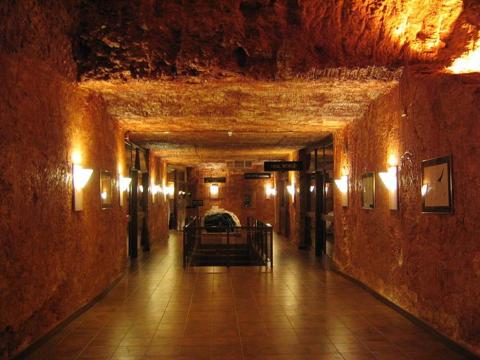In the remote South Australian desert, where temperatures are known to reach 125 °F in the shade, there is a town named Coober Pedy, where residents have dug themselves underground to escape the blistering heat. Once the largest opal mining operation in the world, Coober Pedy is now a peculiar site where chimneys rise from the sand and signs warn people of unmarked holes in the ground.
Coober Pedy was founded in the early 1900s as a result of the discovery of opals in the area. Today it is home to around 3,500 residents – most of whom live in subterranean ‘dugouts’ – as well as flocks of tourists who travel over 8 hours from the nearest city, Adelaide, to visit this ‘opal capital of the world’.
Coober Pedy Before the Whitefella
The name Coober Pedy comes from the Aboriginal name Kupa Piti, which means Whitefella’s (or White Man’s) Hole and is reflective of the mining activities that commenced there after 1915. Prior to this, Aboriginal people had been living in the area for thousands of years.
Being a desert environment, the people were nomadic hunters and gatherers who moved around constantly in search of food and water, but they also had several sacred sites in the area, where they engaged in traditional ceremonies.
When opal was discovered, and settlers moved in to begin mining operations, they brought with them diseases such as influenza, tuberculosis, and measles, which the indigenous people had no immunity to and many of them died. Today, between 300 – 500 of the residents of Coober Pedy are indigenous.
The Foundation of Coober Pedy
In early 1915, the New Colorado Prospecting Syndicate had been prospecting for gold just south of Coober Pedy. This syndicate, which consisted of Jim Hutchison, his 14-year-old son, William, and two other associates, had set up camp after their unsuccessful prospection. On the 1st of February, as the men went in search of water, William stumbled upon several pieces of opal simply lying on the surface of the ground. Further investigations revealed an abundance of the valuable gem, and so, the mining town of Coober Pedy was born.

Rough opal from Coober Pedy, South Australia (Dpulitzer/CC BY SA 3.0)
Since William Hutchison’s discovery of the first opal pieces, Coober Pedy has grown to be the world’s largest supplier of opal. By 1999, there were more than 250,000 mine shaft entrances in the area – a particular hazard for both residents and tourists.
Underground Living
A unique feature of Coober Pedy is that it is almost entirely underground. The early opal miners who followed in the footsteps of the New Colorado Prospecting Syndicate had initially built their residences above the ground. They tried to adapt to the harsh climate, which was extremely hot in the day and very cold at night. Soon, however, they were struck by inspiration to live underground in caves bored into the hillsides, known as ‘dugouts’, where the temperature would be constant and neither too hot, nor too cold.
Apart from touring an underground town, and staying in underground hotels, visitors also have the opportunity to partake in ‘noodling’ or ‘fossicking’, also known as looking for opal amongst the rubble.
Top image: Inside Coober Pedy, South Australia. (Phil Whitehouse/CC BY 2.0)




